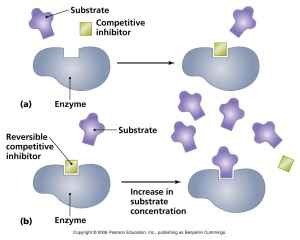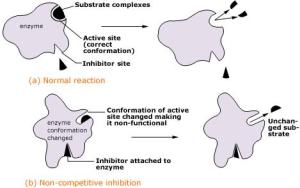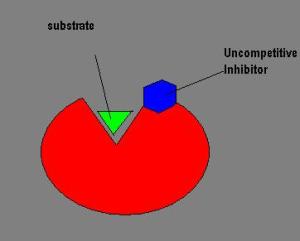So its 1:45am and here i was thinking that “The Perfect Fit” would be my last enzyme blog entry. Then i turned the page in my notebook and BAM, a whole other section about inhibition of enzymes. Weh. This is pretty simple to understand though, it just needs to be remembered. So without further discussion of non-bio things, Let’s begin:
- Competitive inhibition
- Non-Competitive inhibition
- Uncompetitive inhibition
- Mixed inhibition
Four easy yet useful stuff!
All inhibitors change the shape of the active site of the enzyme, thereby preventing a reaction from occurring since the specific shape of the substrate cannot bind to this new shape. Its like cock-blocking at a molecular level.
Reversible inhibition: inhibitors can bind to enzymes through weak non-covalent interactions ( ionic bonds, hydrophobic interactions, and hydrogen bonds) but because reversible inhibitors do not form any chemical bonds or reactions with the enzyme, they are formed rapidly and can be easily removed. Thus the enzyme and inhibitor complex is rapidly dissociated in contrast to irreversible inhibition.
Competitive inhibition: inhibitors bind reversibly to the same site (active site) that the substrate would occupy. By increasing substrate concentration, effect of inhibitor is reduced.
academic.pgcc.edu
Non-Competitive inhibition: inhibitors and substrate binds on different sites of the enzyme. The inhibitor can either bind with free enzymes, or the enzyme-substrate complex. Concentration of substrate would therefore not affect inhibitors since it can bind elsewhere.
Uncompetitive inhibition: inhibitor binds only to the enzyme-substrate complex, at a separate site from the substrate binds, and not with free enzymes.
en.wikibooks.org
Mixed inhibition: inhibitor binds at a separate site from the substrate’s active site, to either free enzymes or enzyme-substrate complex. It sounds similar to non-competitive inhibition doesn’t it? However the difference is that the enzyme-substrate complex has residual enzymatic activity.
en.wikipedia.org
Now you guys know how much i love my youtube videos! its a little longer than usual, but its worth it!


